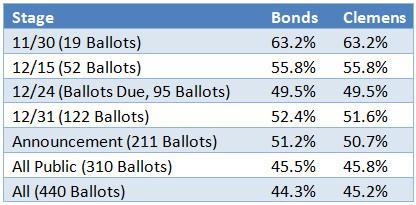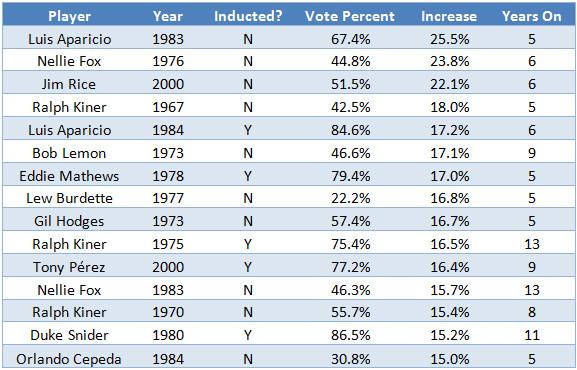The last day of this year is the deadline for Hall of Fame ballots, which means that more than 400 long-tenured members of the Baseball Writers’ Association of America have homework due. While we won’t know the full fruits of their voting until the middle of next month, it’s safe to say that for their fifth consecutive year of eligibility, the best hitter and best pitcher of the past eight or nine decades will not be inducted. Barry Bonds and Roger Clemens rank fourth and eighth, respectively, in all-time wins above replacement. But steroids probably played a part in their anomalous late-career production, and for that, they’ve been kept in PED purgatory.
For the first time, though, that wait doesn’t seem likely to outlast their stay on the ballot. After years of stagnation, Bonds, Clemens, and other Cooperstown candidates with PED stigmas are surging in the early returns, which suggests that we’ve reached an apparent tipping point in baseball’s tiresome struggle to reconcile its PED past. We can’t close the book on that era, but we’re starting to see what its last chapter will look like.
A little more than a third of the electorate rallied behind the Bonds-Clemens camp from the start, some with enthusiasm and some with slight distaste. The early adopters of 2012 were the purely performance-based voters or, as Joe Posnanski put it, those who regard induction more as an “acknowledgement of greatness” than an honor requiring perfect career-long comportment. In their first year on the ballot, the two players (whose vote percentages, as one would expect, have almost mirrored each other through their first four years) placed in the mid-30s. In their second year, their percentages sank. By last year, they’d rebounded, but only modestly, climbing about eight percentage points relative to their debuts on the ballot four years before. There wasn’t much momentum behind the Bonds-Clemens cases, and their prospects for induction by the BBWAA before their 10 years on the ballot were up still seemed remote.
Then this year’s ballots started trickling in, and along with the perennial river of Hall of Fame columns and tweets came an unexpected spike in checks in the “Bonds” and “Clemens” boxes. According to the ballot tracker maintained by the tireless Ryan Thibodaux, Bonds and Clemens are up to 71.1 percent support through 135 known ballots, an estimated 31 percent of the total pool. Of course, it’s likely that they’ll finish far below 70 percent, let alone the 75 percent required for enshrinement, because Bonds and Clemens supporters tend to be overrepresented among voters who make their ballots public, especially those who release their ballots before they’re due. We can get a feel for how far, though, by examining last year’s results.
In the final tally for last year’s class, support for Bonds and Clemens was only slightly higher (3.9 percentage points and 2.0 percentage points, respectively) among voters who disclosed their ballots than those who kept them private. But the two players’ percentages on Thibodaux’s tracker were much higher earlier in the voting period than they were at the end. The table below shows where their tracker tallies stood at several stages leading up to the big reveal.

Thus far, the numbers for Bonds and Clemens haven’t significantly worsened as Thibodaux has hunted down ballots; their percentages today are actually higher than they were on November 30 (through 11 ballots) or December 15 (47 ballots). As of last December 31, though, support for Bonds and Clemens on known public ballots was about eight percentage points higher than their final, overall marks turned out to be (albeit with fewer public ballots collected through that point than Thibodaux has already tracked this year). Even if we assume a similar drop-off from their current percentages on Thibodaux’s tracker, their official totals would still sit at 64 percent, an increase from last season of about 19 percentage points.
That’s huge, historically speaking. For the Hall of Fame’s first few decades, the voting process shape-shifted from cycle to cycle. But if we use Hall of Fame analyst Jay Jaffe’s cutoff of 1966 as the “modern era” of voting, we find few recent precedents for one-year jumps that big by players in their fifth year of eligibility or later who weren’t in their final year of eligibility (when a last push by procrastinating voters sometimes yields a big bump). Of the players who qualify (most of whom date from decades ago), only Gil Hodges failed to earn induction eventually.

So how did two widely reviled poster players of the PED era go from long shots to likely future inductees so suddenly? It wasn’t one thing, but a combination of factors that converged in time to help the more morally ambiguous members of the aspiring Cooperstown Class of 2017. Thibodaux’s tracker already includes 16 voters who’ve flipped from “no” to “yes” on both Bonds and Clemens this year, as well as the Daily Herald’s Barry Rozner, who voted for Bonds last year but has since switched from “no” to “yes” on Clemens. (The New York Post’s George Willis, who told me he changed his vote after a conversation with a childhood mentor who convinced him that steroid users have done damage to the game, is the only voter known to have switched from “yes” to “no” on either player since last year.) A few of the Bonds and Clemens converts have already analyzed their own reasoning in print, but I reached out to the rest via email for explanations, and a few refrains emerged.
Above all else, there’s the Bud Selig factor. Early this month, the Hall of Fame’s “Today’s Game” Committee — a 16-member body that considers players, managers, umpires, and executives who aren’t eligible for the BBWAA ballot — inducted Selig, the recently retired commissioner who presided over the most tainted portion of the so-called “Steroid Era” and was slow to regulate the game’s permissive PED culture. Selig made many other contributions that, when combined, could be considered deserving of induction, but that’s the point: In the eyes of the voters, the positives outweighed the PED problem. And if the PED stain wasn’t disqualifying in Selig’s case, some voters decided, it shouldn’t be for Bonds or Clemens, who also seemed to do enough to deserve induction before the steroids whispers (and later, shouts) started. Moreover, barring Bonds and Clemens for their ties to PEDs after the admittance of a man who turned a blind eye to (and tacitly condoned) their behavior and the behavior of many more like them was too philosophically inconsistent for some voters to square.
“The idea of ‘punishing’ the two best players of that era while the commissioner who stood by and watched it all happen goes into Cooperstown just hit me as wrong,” one of the vote-switchers, Kevin Cooney of the Bucks County Courier Times, told me. “If Selig and Tony La Russa are in without having to pass the writers gauntlet — then I feel that in fairness it is time to put Bonds and Clemens in.”
Rozner, the voter who switched to “yes” on Clemens, is another BBWAA member for whom Selig’s induction erased any concerns about rule no. 5 on the Hall of Fame’s voting guidelines, commonly known as the character clause. “I’ve always voted for Bonds, who was a Hall of Famer before he started using,” Rozner says. “It wasn’t as clear to me when Clemens started. But with the election of Bud Selig, I see no point in adhering to rule no. 5.” The list of vote-switchers swayed by Selig’s induction goes on: Bruce Miles, Jeff Jacobs, Steve Buckley, Peter Botte.
In light of Selig’s longevity and impact, his induction didn’t come as a surprise, but it was easy to ignore the ramifications until his enshrinement became official. Because the BBWAA didn’t induct Selig, it wouldn’t necessarily be hypocritical for a writer to exclude a qualified statistical candidate for PED-related reasons. But Selig’s quick path to a plaque does make it more difficult to pretend that the Hall hasn’t already been sullied by whatever insidious PED presence the hardliners were quixotically trying to keep out of Cooperstown. One vote-switcher, the Associated Press’s Bernie Wilson, says that in part because of Selig, he “realized that it was time to stop playing morality cop. Let’s admit that the quaint concept of integrity in baseball is BS, so why should we care anymore? … I’ve finally bought the argument that the Hall should accurately depict every era in baseball, warts, miscreants and all.”
Tom D’Angelo of the Palm Beach Post says that Selig’s induction sealed his vote but that by then, he’d already become convinced that he’d been “using a double standard to keep [Bonds and Clemens] out and continue to vote in other players from that era linked to PEDs, even if through suspicion.” MASN’s Roch Kubatko, a first-time Bonds/Clemens supporter, says Selig’s status wasn’t a consideration for him. What made up his mind was the inexorable accumulation of other PED guys, or rumored PED guys, who made taking a stance against the most talented two untenable. “Manny Ramírez is now on [the ballot] … and others are trickling on who carry suspicions,” Kubatko says. “Where do you draw the line? It just felt wrong after a while to vote for some guys and not others.”
Other writers also seem to be suffering from decision fatigue after years of trying to separate “clean” players from no-good, cheating cheaters without all of the information needed to draw such distinctions. “This is my third year voting for the Hall of Fame, and I’ve grappled internally (and externally) with the Roger Clemens and Barry Bonds dilemma each time,” says Fox Sports MLB editor Chris Bahr, who checked both boxes this year. “I was very close to voting for them both last year but opted not to at the last minute. I just couldn’t get past my PEDs doubts.” This time, Bahr simplified his process. “It boils down to this: I chose to vote on facts (stats, accomplishments, awards, etc.) rather than speculation and uncertainty,” he says.
More and more writers are taking that voluntary tumble down the slippery slope, deciding whether to tick boxes by applying the transitive property that’s always eased voters’ minds: If Player A is a Hall of Famer and Player B has as strong a case as Player A, then Player B should be a Hall of Famer also. The only difference is that they’re now making those calculations based on degrees of PED suspicion in addition to stats.
“If [Mike] Piazza was in, [Iván Rodríguez] should be in,” says vote-switcher Gene Myers, former sports editor for the Detroit Free Press. “And Piazza really was the first star with a huge PED stigma to make it.” Wilson agrees that Rodríguez being on the ballot “pretty much forces the issue,” saying, “although Pudge never flunked a test, that we know of, there certainly were suspicions … so if I voted for Pudge, I needed to vote for Bonds and Clemens.”
Players such as Piazza, Rodríguez (85.2 percent on Thibodaux’s tracker) and Jeff Bagwell (93.3 percent), the last two of whom have solid-to-excellent odds of joining Piazza in Cooperstown next summer, have arguably been the serious Hall of Fame candidates who’ve suffered the most unjustly from prevailing PED angst. Although no jaded fan of 1990s and early 2000s baseball would wager much on their innocence, the evidence of their guilt is fairly flimsy, resting on unsubstantiated accusations, perplexing no-comments, weight gain or loss, or back acne. The steroid stories surrounding players such as Bonds and Clemens have contributed to the perception that PED use was extremely widespread during their era, which casts doubt on other impressive performances by players with more tenuous ties to chemical enhancement. And now some of those players might be the wedges that drive the doors open wide enough for Clemens and a considerably slimmed-down Bonds to slip through.
With Ken Griffey Jr. and Piazza getting in last year, Alan Trammell and Mark McGwire exhausting their eligibility, and Curt Schilling alienating supporters every time he talks, there are more free spots to be distributed, and voters aren’t skimping on names. The average public voter on Thibodaux’s tracker has voted in favor of 8.9 out of a maximum of 10 candidates, which would be an increase from 8.2 last year. For the second consecutive year, Edgar Martínez and Mike Mussina are in line for sizable boosts, and Tim Raines will very likely cross the 75 percent threshold in his final time on the ballot. But players with PED associations are probably also benefiting from the slightly reduced backlog. MLB.com columnist Richard Justice told me that he didn’t vote for Bonds and Clemens last year (after voting for them in previous years) because he couldn’t “jam 14/15/16 names onto a 10-player limit” and was worried about other players falling off the ballot. “My ballot was not a reflection of any moral/ethical stand against Bonds/Clemens,” he added. “I don’t feel I’m in any position to be a character judge of those guys.”
The five-year period that separates players’ last active seasons from their first year on the ballot is supposed to provide the perspective that leads to enlightened votes and certainty. With Bonds and Clemens, those first five years weren’t enough, so some writers mentally doubled them. “I planned all along to vote for Bonds and Clemens after five or so years on the ballot, figuring that might be enough time to sort out the PED issue,” the AP’s Wilson says.
It’s still only sort of sorted out; clarity didn’t come to every voter at once. For writers on both sides of the issue, the PED problem remains messy and muddled and unsatisfying. That’s often how history works. But we’re crawling toward a consensus that should settle and solidify as older, inactive, and more anti-PED-oriented voters continue to be removed from the rolls. If — or, as now seems much more likely, when — Bonds and Clemens get in, it could clear a path for more of their contemporaries, although PED-connected players who had borderline stats or who were suspended after MLB put testing policies in place would still face a steep climb.
Garry Brown, a 30-year BBWAA member and new Bonds/Clemens backer, was swayed by the argument that it didn’t make sense to selectively punish players from a PED-saturated era, but his rejiggered ballot hasn’t brought him peace of mind. “That’s why I changed, but I don’t feel good about it,” Brown says. “Nor did I feel good when I didn’t vote in all those years for the ‘steroid guys.’”
Soon the aggressive gatekeeping will all be behind us, and more of baseball’s best players ever will be where they belong. The Hall can put them on plaques and tell us their truths; we’ll add the asterisks on our own.
Thanks to Hans Van Slooten of Baseball-Reference and Ryan Thibodaux for research assistance.
